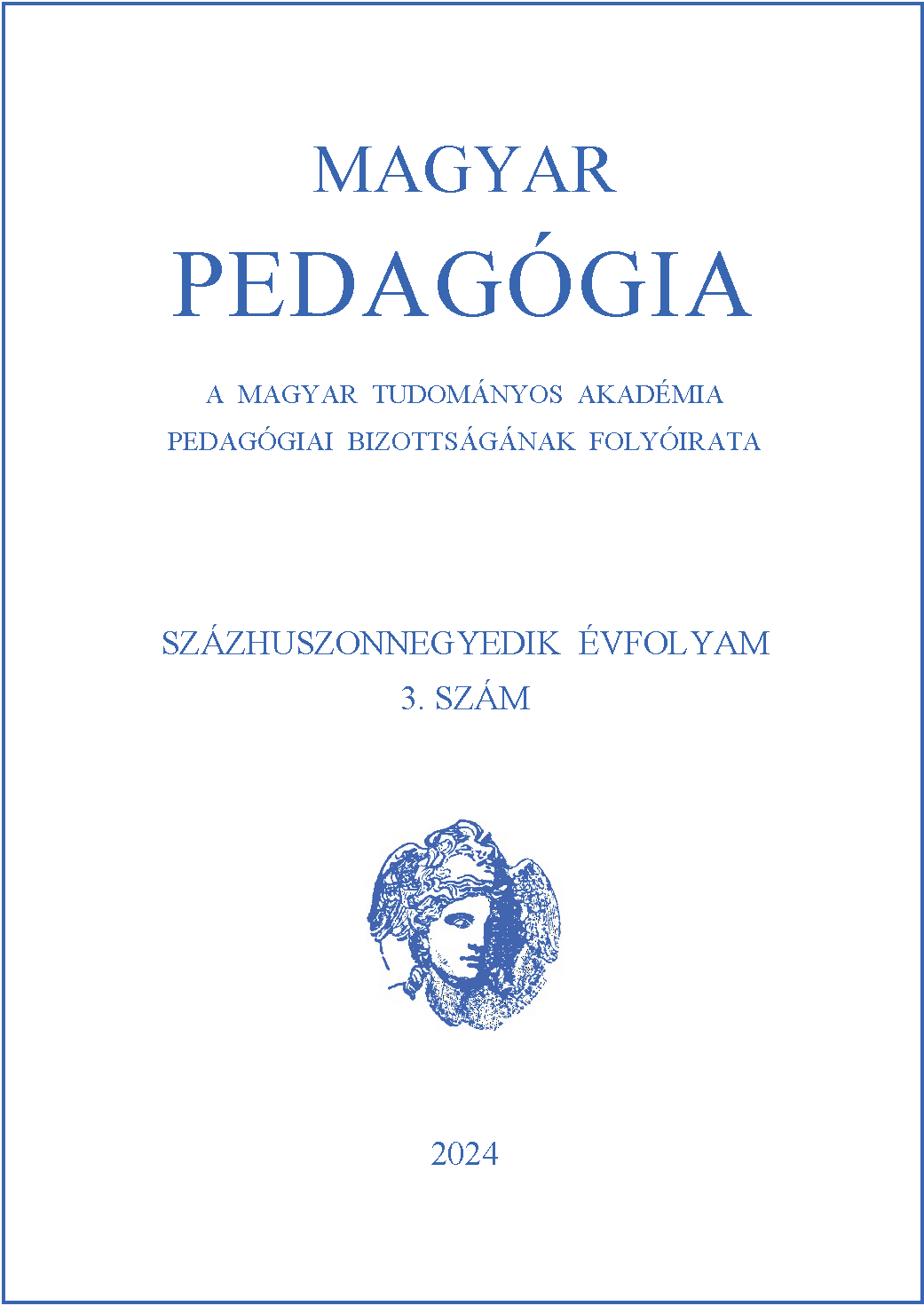A hangos olvasási fluencia képességének és összefüggéseinek vizsgálata második osztályos tanulók körében
Main Article Content
Absztrakt
Az olvasási fluencia képessége szoros összefüggésben áll a szövegértő olvasás eredményességével, ezáltal a tanulás sikerességére is hatást gyakorol (Fuchs et al. 2001, Kuhn et al. 2010). Tanulmányunk az olvasási fluencia kialakulása és fejlődése szempontjából egy igen fontos szakaszban, második osztályos korban vizsgálja a hangos olvasási fluencia képességét, jellemzőit és összefüggéseit. A kutatásban 21 iskola 33 osztályának 658 tanulója vett részt. A felmérésben szereplő 144 szóból álló mese olvasására fordított idő átlaga 221,25 másodperc volt, magas, 114,83 másodperces szórás mellett. A diákok percenként 47,38 szót olvastak átlagosan, az elsőre helyesen elolvasott szavak átlaga 45,19 szót percenként. Eredményeink a más nyelveken tapasztaltakhoz hasonlóan igazolták az összefüggést a három komponens, az olvasás ideje, pontossága és prozódiai jellemzői, illetve a szövegértés eredménye között. A hangos olvasási fluencia hazai vizsgálata lehetővé teszi az eredmények értelmezését és elhelyezését a nemzetközi tudományos diskurzusban, illetve megkönnyíti, hogy az ott igazoltak alapján hatékony fejlesztéseket adaptáljunk és alakítsunk ki a magyar olvasástanítási rendszerben is.
Letöltések
Article Details
Funding data
-
Magyar Tudományos Akadémia
Grant numbers Közoktatás-fejlesztési Kutatási Program
Hivatkozások
Abadzi, H. (2011). Reading fluency measurements in EFA FTI partner countries: Outcomes and improvement prospects (Tech. Rep.). Global Partnership for Education; World Bank. Washington, DC, USA.
Afflerbach, P., Pearson, P. D., & Paris, S. G. (2008). Clarifying differences between reading skills and reading strategies. The Reading Teacher, 61(5), 364–373. https://doi.org/10.1598/RT.61.5.1
Benjamin, R. G., & Schwanenflugel, P. J. (2010). Text complexity and oral reading prosody in young readers. Reading Research Quarterly, 45(4), 388–404. https://doi.org/10.1598/RRQ.45.4.2
Bogdán, P. (2024). Angol nyelvű olvashatósági formulák magyar nyelvi adaptálásának lehetséges irányai. Iskolakultúra, 34(1), 69–77.
Carioti, D., Masia, M. F., Travellini, S., & Berlingeri, M. (2021). Orthographic depth and developmental dyslexia: A meta-analytic study. Annals of Dyslexia, 71(3), 399–438. https://doi.org/10.1007/s11881-021-00226-0
Chall, J. (1983). Stages of reading development. McGraw Hill.
Csépe, V. (2014). Az olvasás rendszere, fejlődése és modelljei. In Cs. Pléh & Á. Lukács (Eds.), Pszicholingvisztika 1-2: Magyar pszicholingvisztikai kézikönyv (pp. 339–370). Akadémiai Kiadó.
Csíkos, Cs. (2006). Tudatosság és metakogníció viszonya: Az ezredforduló interdiszciplináris megközelítései. Iskolakultúra, 16(12), 69–82.
Csíkos, Cs. (2007). Metakogníció – A tudásra vonatkozó tudás pedagógiája. Műszaki Kiadó.
Daane, M. C., Campbell, J. R., Grigg, W. S., Goodman, M. J., & Oranje, A. (2005). Fourth-grade students reading aloud: NAEP 2002 special study of oral reading (NCES 2006-469). U.S. Department of Education, Institute of Education Sciences, National Center for Education Statistics. Washington, DC, USA.
DuBay, W. H. (2004). The principles of readability. Online submission. https://files.eric.ed.gov/fulltext/ED490073.pdf
Ecalle, J., Gomes, C., Auphan, P., Cros, L., & Magnan, A. (2019). Effects of policy and educational interventions intended to reduce difficulties in literacy skills in Grade 1. Studies in Educational Evaluation, 61, 12–20. https://doi.org/10.1016/j.stueduc.2019.02.001
Fuchs, L. S., Fuchs, D., & O’Connor, R. E. (2001). The role of fluency in reading comprehension: An overview. Reading Research Quarterly, 36(3), 256–272. https://doi.org/10.1598/RRQ.36.3.1
Fuchs, L. S., Fuchs, D., Hosp, M. K., & Jenkins, J. R. (2001). Oral reading fluency as an indicator of reading competence: A theoretical, empirical, and historical analysis. Scientific Studies of Reading, 5(3), 239–256. https://doi.org/10.1207/S1532799XSSR0503_3
Good, R. H., Simmons, D. C., & Kame’enui, E. J. (2001). The importance and use of fluency measures in basic early literacy skills assessment. Exceptional Children, 67(4), 535–552. https://doi.org/10.1177/001440290106700407
Hasbrouck, J., & Tindal, G. (2006). Oral reading fluency norms: A valuable assessment tool for reading teachers. The Reading Teacher, 59(7), 636–644. https://doi.org/10.1598/RT.59.7.3
Hudson, R. F., Lane, H. B., & Pullen, P. C. (2005). Reading fluency assessment and instruction: What, why, and how? The Reading Teacher, 58(8), 702–714. https://doi.org/10.1598/RT.58.8.1
Hudson, R. F., Pullen, P. C., Lane, H. B., & Torgesen, J. K. (2008). The complex nature of reading fluency: A multidimensional view. Reading & Writing Quarterly, 25(1), 4–32. https://doi.org/10.1080/10573560802491208
Hudson, A., Koh, P. W., Moore, K. A., & Binks-Cantrell, E. (2020). Fluency interventions for elementary students with reading difficulties: A synthesis of research from 2000–2019. Education Sciences, 10(3), 52. https://doi.org/10.3390/educsci10030052
Kuhn, M. R., & Stahl, S. A. (2003). Fluency: A review of developmental and remedial practices. Journal of Educational Psychology, 95(1), 3–21. https://doi.org/10.1037/0022-0663.95.1.3
Kuhn, M. R., Schwanenflugel, P. J., Meisinger, E. B., Levy, B. A., & Rasinski, T. V. (2010). Aligning theory and assessment of reading fluency: Automaticity, prosody, and definitions of fluency. Reading Research Quarterly, 45(2), 230–251. https://doi.org/10.1598/RRQ.45.2.4
Kuhn, M. R., Schwanenflugel, P. J., Morris, R. D., Morrow, L. M., Woo, D. G., Meisinger, E. B., Sevcik, R. A., Bradley, B. A., & Stahl, S. A. (2010). Teaching children to become fluent and automatic readers. Journal of Literacy Research, 42(3), 259–289. https://doi.org/10.1080/1086296X.2010.503551
Kuhn, M. R., Schwanenflugel, P. J., Morris, R. D., Morrow, L. M., Woo, D. G., Meisinger, E. B., Sevcik, R. A., ... & Stahl, S. A. (2010). Teaching children to become fluent and automatic readers. Reading Research Quarterly, 45(4), 352–378. https://doi.org/10.1598/RRQ.45.4.2
LaBerge, D., & Samuels, S. J. (1974). Toward a theory of automatic information processing in reading. Cognitive Psychology, 6(2), 293–323. https://doi.org/10.1016/0010-0285(74)90015-2
Logan, G. D. (1988). Toward an instance theory of automatization. Psychological Review, 95(4), 492–527. https://doi.org/10.1037/0033-295X.95.4.492
Logan, G. D. (1997). Automaticity and reading: Perspectives from the instance theory of automatization. Reading & Writing Quarterly: Overcoming Learning Difficulties, 13(2), 123–146. https://doi.org/10.1080/1057356970130203
Maki, K. E., Ittner, A., Pulles, S. M., & Clemens, N. H. (2022). Effects of an abbreviated class-wide reading intervention for students in third grade. Contemporary School Psychology, 26, 359–367. https://doi.org/10.1007/s40688-020-00343-4
Metsala, J. L., & David, M. D. (2022). Improving English reading fluency and comprehension for children with reading fluency disabilities. Dyslexia, 28(1), 79–96. https://doi.org/10.1002/dys.1695
Miller, J., & Schwanenflugel, P. J. (2006). Prosody of syntactically complex sentences in the story speech of African American preschoolers. Journal of Speech, Language, and Hearing Research, 49(5), 1049–1064. https://doi.org/10.1044/1092-4388(2006/075)
Miller, J., & Schwanenflugel, P. J. (2008). A longitudinal study of the development of reading prosody as a dimension of oral reading fluency in early elementary school children. Reading Research Quarterly, 43(4), 336–354. https://doi.org/10.1598/RRQ.43.4.2
Perfetti, C. A. (1985). Reading ability. Oxford University Press.
Pinnell, G. S., Pikulski, J. J., Wixson, K. K., Campbell, J. R., Gough, P. B., & Beatty, A. S. (1995). Listening to children read aloud: Data from NAEP's Integrated Reading Performance Record (IRPR) at grade 4. National Center for Education Statistics.
Querido, L., Fernandes, S., & Verhaeghe, A. (2021). Orthographic knowledge, and reading and spelling: A longitudinal study in an intermediate depth orthography. The Spanish Journal of Psychology, 24, e3. https://doi.org/10.1017/SJP.2021.3
Rasinski, T. V. (2000). Speed does matter in reading. The Reading Teacher, 54(2), 146–151.
Rasinski, T. V. (2004). Assessing reading fluency. Pacific Resources for Education and Learning. https://files.eric.ed.gov/fulltext/ED483166.pdf
Rasinski, T. V. (2004). Why does reading fluency matter? Journal of Literacy Research, 36(1), 94–98. https://doi.org/10.1207/s15548430jlr3601_4
Rasinski, T. V. (2012). Why reading fluency should be hot! The Reading Teacher, 65(8), 516–522. https://doi.org/10.1002/TRTR.01077
Ravid, D., & Mashraki, Y. E. (2007). Prosodic reading, reading comprehension and morphological skills in Hebrew-speaking fourth graders. Journal of Research in Reading, 30(2), 140–156. https://doi.org/10.1111/j.1467-9817.2007.00335.x
Samuels, S. J. (2006). Toward a model of reading fluency. In S. J. Samuels & A. E. Farstrup (Eds.), What research has to say about fluency instruction (pp. 24–46). International Reading Association.
Schneider, W., & Shiffrin, R. M. (1977). Controlled and automatic human information processing: I. Detection, search, and attention. Psychological Review, 84(1), 1–66. https://doi.org/10.1037/0033-295X.84.1.1
Schreiber, P. A. (1980). On the acquisition of reading fluency. Journal of Reading Behavior, 12(3), 177–186. https://doi.org/10.1080/10862968009547369
Schwanenflugel, P. J., Hamilton, A. M., Kuhn, M. R., Wisenbaker, J. M., & Stahl, S. A. (2004). Becoming a fluent reader: Reading skill and prosodic features in the oral reading of young readers. Journal of Educational Psychology, 96(1), 119–129. https://doi.org/10.1037/0022-0663.96.1.119
Schwanenflugel, P. J., Hamilton, K., & Kuhn, M. R. (2006). The role of fluency in reading comprehension. Reading & Writing Quarterly, 22(3), 289–306. https://doi.org/10.1080/10573560500455703
Silverman, R. D., Speece, D. L., Harring, K. R., & Ritchey, K. D. (2012). Fluency has a role in the simple view of reading. Scientific Studies of Reading, 17(2), 108–133. https://doi.org/10.1080/10888438.2011.618153
Sipos, Zs. (2022). Szocioökonómiai sajátosságok hatása az olvasástechnika elsajátítására második évfolyamos tanulók vizsgálata alapján. Anyanyelv-pedagógia, 15(3). https://doi.org/10.21030/anyp.2022.3.1
Sipos, Zs. (2023). Negyedik évfolyamos tanulók olvasástechnikai sajátosságai és azok pedagógiai relevanciája [Doctoral dissertation, SZTE Neveléstudományi Doktori Iskola].
Steklács, J. (2024). Az olvasási fluencia fogalma és jelentősége az olvasástanítás rendszerében: Egy feltáró kutatás elméleti háttere és a paradigmaváltás kérdései. Anyanyelv-pedagógia, 17(2), 1–19. https://doi.org/10.21030/anyp.2024.2.1
Torgesen, J. K., Rashotte, C. A., Alexander, A., Alexander, J., & MacPhee, K. (2003). Progress toward understanding the instructional conditions necessary for remediating reading difficulties in older children. In B. R. Foorman (Ed.), Preventing and remediating reading difficulties: Bringing science to scale (pp. 275–298). York Press.
Tyler, E. J., Hughes, J. C., Beverley, M., & Hastings, R. P. (2015). Improving early reading skills for beginning readers using an online programme as supplementary instruction. European Journal of Psychology of Education, 30(3), 281–294. https://doi.org/10.1007/s10212-014-0244-3
Wagner, R. K., & Torgesen, J. K. (1987). The nature of phonological processing and its causal role in the acquisition of reading skills. Psychological Bulletin, 101(2), 192–212. https://doi.org/10.1037/0033-2909.101.2.192
Ziegler, J. C., & Goswami, U. (2005). Reading acquisition, developmental dyslexia, and skilled reading across languages: A psycholinguistic grain size theory. Psychological Bulletin, 131(1), 3–29. https://doi.org/10.1037/0033-2909.131.1.3

